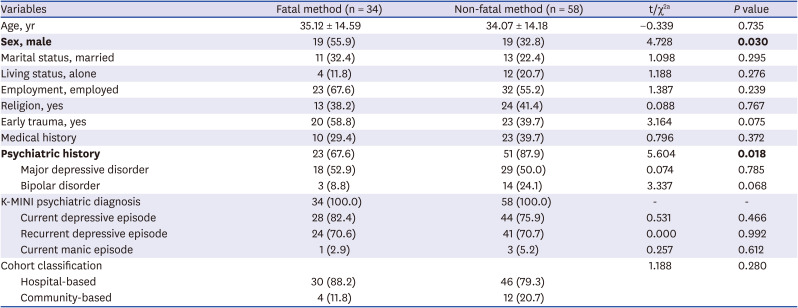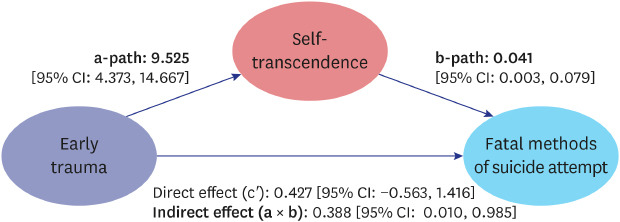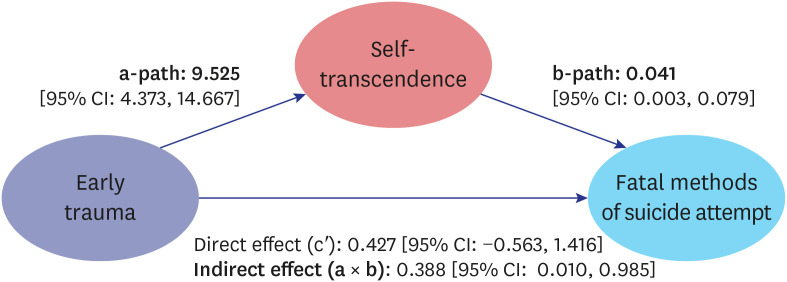3. Kim YE, Park H, Jo MW, Oh IH, Go DS, Jung J, et al. Trends and patterns of burden of disease and injuries in Korea using disability-adjusted life years. J Korean Med Sci. 2019; 34(Suppl 1):e75. PMID:
30923488.

4. Kim YE, Lee YR, Yoon SJ, Kim YA, Oh IH. Years of life lost due to premature death in people with disabilities in Korea: the Korean National Burden of Disease Study Framework. J Korean Med Sci. 2019; 34(2):e22. PMID:
30636948.

5. Seoul National University College of Medicine. 2018 National Survey on Suicide. Seoul, Korea: Ministry of Health and Welfare;2019.
6. Bostwick JM, Pabbati C, Geske JR, McKean AJ. Suicide attempt as a risk factor for completed suicide: even more lethal than we knew. Am J Psychiatry. 2016; 173(11):1094–1100. PMID:
27523496.



7. Parra-Uribe I, Blasco-Fontecilla H, Garcia-Parés G, Martínez-Naval L, Valero-Coppin O, Cebrià-Meca A, et al. Risk of re-attempts and suicide death after a suicide attempt: a survival analysis. BMC Psychiatry. 2017; 17(1):163. PMID:
28472923.

8. Spicer RS, Miller TR. Suicide acts in 8 states: incidence and case fatality rates by demographics and method. Am J Public Health. 2000; 90(12):1885–1891. PMID:
11111261.



9. Lim M, Lee SU, Park JI. Difference in suicide methods used between suicide attempters and suicide completers. Int J Ment Health Syst. 2014; 8(1):54. PMID:
25584067.



10. Allen AR, Hagen KM. Trauma and suicide: a pilot study assessing risk in adults diagnosed with schizophrenia spectrum disorders. J Nerv Ment Dis. 2020; 208(5):431–434. PMID:
32282551.

11. Maltsberger JT. Reducing suicide: a national imperative. J Nerv Ment Dis. 2003; 191(9):623–624.

12. Woo J, Chang SM, Hong JP, Lee DW, Hahm BJ, Cho SJ, et al. The association of childhood experience of peer bullying with DSM-IV psychiatric disorders and suicidality in adults: results from a nationwide survey in Korea. J Korean Med Sci. 2019; 34(46):e295. PMID:
31779057.

13. Brown J, Cohen P, Johnson JG, Smailes EM. Childhood abuse and neglect: specificity of effects on adolescent and young adult depression and suicidality. J Am Acad Child Adolesc Psychiatry. 1999; 38(12):1490–1496. PMID:
10596248.


14. Cero I, Sifers S. Moderating factors in the path from physical abuse to attempted suicide in adolescents: application of the interpersonal-psychological theory of suicide. Suicide Life Threat Behav. 2013; 43(3):296–304. PMID:
23379475.


15. Pompili M, Iliceto P, Innamorati M, Rihmer Z, Lester D, Akiskal HS, et al. Suicide risk and personality traits in physically and/or sexually abused acute psychiatric inpatients: a preliminary study. Psychol Rep. 2009; 105(2):554–568. PMID:
19928616.


16. Fergusson DM, Woodward LJ, Horwood LJ. Risk factors and life processes associated with the onset of suicidal behaviour during adolescence and early adulthood. Psychol Med. 2000; 30(1):23–39. PMID:
10722173.


17. Paolucci EO, Genuis ML, Violato C. A meta-analysis of the published research on the effects of child sexual abuse. J Psychol. 2001; 135(1):17–36. PMID:
11235837.


18. De Bellis MD, Zisk A. The biological effects of childhood trauma. Child Adolesc Psychiatr Clin N Am. 2014; 23(2):185–222. PMID:
24656576.



19. Margolin G, Gordis EB. The effects of family and community violence on children. Annu Rev Psychol. 2000; 51(1):445–479. PMID:
10751978.


20. Braquehais MD, Oquendo MA, Baca-García E, Sher L. Is impulsivity a link between childhood abuse and suicide? Compr Psychiatry. 2010; 51(2):121–129. PMID:
20152291.


21. Cloninger CR, Svrakic DM, Przybeck TR. A psychobiological model of temperament and character. Arch Gen Psychiatry. 1993; 50(12):975–990. PMID:
8250684.


22. de Carvalho HW, Pereira R, Frozi J, Bisol LW, Ottoni GL, Lara DR. Childhood trauma is associated with maladaptive personality traits. Child Abuse Negl. 2015; 44:18–25. PMID:
25541148.


23. Rademaker AR, Vermetten E, Geuze E, Muilwijk A, Kleber RJ. Self-reported early trauma as a predictor of adult personality: a study in a military sample. J Clin Psychol. 2008; 64(7):863–875. PMID:
18428119.


25. Joyce PR, Light KJ, Rowe SL, Cloninger CR, Kennedy MA. Self-mutilation and suicide attempts: relationships to bipolar disorder, borderline personality disorder, temperament and character. Aust N Z J Psychiatry. 2010; 44(3):250–257. PMID:
20180727.


26. Jylhä PJ, Rosenström T, Mantere O, Suominen K, Melartin TK, Vuorilehto MS, et al. Temperament, character, and suicide attempts in unipolar and bipolar mood disorders. J Clin Psychiatry. 2016; 77(2):252–260. PMID:
26797163.


27. Perroud N, Baud P, Ardu S, Krejci I, Mouthon D, Vessaz M, et al. Temperament personality profiles in suicidal behaviour: an investigation of associated demographic, clinical and genetic factors. J Affect Disord. 2013; 146(2):246–253. PMID:
23044284.


28. Conrad R, Walz F, Geiser F, Imbierowicz K, Liedtke R, Wegener I. Temperament and character personality profile in relation to suicidal ideation and suicide attempts in major depressed patients. Psychiatry Res. 2009; 170(2-3):212–217. PMID:
19897251.


29. Anderson CB, Carter FA, McIntosh VV, Joyce PR, Bulik CM. Self-harm and suicide attempts in individuals with bulimia nervosa. Eat Disord. 2002; 10(3):227–243. PMID:
16864266.


30. Fico G, Caivano V, Zinno F, Carfagno M, Steardo LJ, Sampogna G, et al. Affective temperaments and clinical course of bipolar disorder: an exploratory study of differences among patients with and without a history of violent suicide attempts. Medicina (Kaunas). 2019; 55(7):E390. PMID:
31331102.

31. Dumais A, Lesage AD, Lalovic A, Séguin M, Tousignant M, Chawky N, et al. Is violent method of suicide a behavioral marker of lifetime aggression? Am J Psychiatry. 2005; 162(7):1375–1378. PMID:
15994723.


32. Denning DG, Conwell Y, King D, Cox C. Method choice, intent, and gender in completed suicide. Suicide Life Threat Behav. 2000; 30(3):282–288. PMID:
11079640.

33. Maes M, Cosyns P, Meltzer HY, De Meyer F, Peeters D. Seasonality in violent suicide but not in nonviolent suicide or homicide. Am J Psychiatry. 1993; 150(9):1380–1385. PMID:
8352350.

34. Conwell Y, Duberstein PR, Cox C, Herrmann J, Forbes N, Caine ED. Age differences in behaviors leading to completed suicide. Am J Geriatr Psychiatry. 1998; 6(2):122–126. PMID:
9581207.


36. Ardani AR, Naghibzadeh B, Farid Hosseini F, Asadpour Z, Khabazianzadeh F. Temperament and character personality profile and affective temperaments in self-poisoning nonlethal suicide attempters. Psychiatry Res. 2015; 229(1-2):394–400. PMID:
26205631.


37. Zdankiewicz-Ścigała E, Ścigała DK. Trauma, temperament, alexithymia, and dissociation among persons addicted to alcohol: mediation model of dependencies. Front Psychol. 2018; 9:1570. PMID:
30245652.

39. Marusak HA, Etkin A, Thomason ME. Disrupted insula-based neural circuit organization and conflict interference in trauma-exposed youth. Neuroimage Clin. 2015; 8:516–525. PMID:
26199869.



40. Carlson EA, Egeland B, Sroufe LA. A prospective investigation of the development of borderline personality symptoms. Dev Psychopathol. 2009; 21(4):1311–1334. PMID:
19825270.


41. Park CH, Lee JW, Lee SY, Moon J, Shim SH, Paik JW, et al. Comparison of baseline characteristics between community-based and hospital-based suicidal ideators and its implications for tailoring strategies for suicide prevention: Korean Cohort for the Model Predicting a Suicide and Suicide-related Behavior. J Korean Med Sci. 2017; 32(9):1522–1533. PMID:
28776350.



42. Park CH, Lee JW, Lee SY, Moon JJ, Jeon DW, Shim SH, et al. The Korean Cohort for the Model Predicting a Suicide and Suicide-related Behavior: study rationale, methodology, and baseline sample characteristics of a long-term, large-scale, multi-center, prospective, naturalistic, observational cohort study. Compr Psychiatry. 2019; 88:29–38. PMID:
30468986.


43. Sheehan DV, Lecrubier Y, Sheehan KH, Amorim P, Janavs J, Weiller E, et al. The Mini-International Neuropsychiatric Interview (M.I.N.I.): the development and validation of a structured diagnostic psychiatric interview for DSM-IV and ICD-10. J Clin Psychiatry. 1998; 59(Suppl 20):22–33.
44. American Psychiatric Association. Diagnostic and Statistical Manual of Mental Disorders. 4th Edition, Text Revision (DSM-IV-TR). Washington, D.C.: American Psychiatric Association;2000.
45. Yoo SW, Kim YS, Noh JS, Oh KS, Kim CH, Namkoong K, et al. Validity of Korean version of the mini-international neuropsychiatric interview. Anxiety Mood. 2006; 2(1):50–55.
46. Bremner JD, Vermetten E, Mazure CM. Development and preliminary psychometric properties of an instrument for the measurement of childhood trauma: the Early Trauma Inventory. Depress Anxiety. 2000; 12(1):1–12. PMID:
10999240.


48. Bernstein DP, Stein JA, Newcomb MD, Walker E, Pogge D, Ahluvalia T, et al. Development and validation of a brief screening version of the Childhood Trauma Questionnaire. Child Abuse Negl. 2003; 27(2):169–190. PMID:
12615092.


49. Beck AT, Ward CH, Mendelson M, Mock J, Erbaugh J. An inventory for measuring depression. Arch Gen Psychiatry. 1961; 4(6):561–571. PMID:
13688369.


50. Beck AT, Epstein N, Brown G, Steer RA. An inventory for measuring clinical anxiety: psychometric properties. J Consult Clin Psychol. 1988; 56(6):893–897. PMID:
3204199.


51. Cloninger CR, Przybeck TR, Svrakic DM. The Temperament and Character Inventory-Revised. St. Louis, MO: Washington University;1999.
52. Oh SH, Lee KU, Kim SH, Park KN, Kim YM, Kim HJ. Factors associated with choice of high lethality methods in suicide attempters: a cross-sectional study. Int J Ment Health Syst. 2014; 8(1):43. PMID:
25926871.



53. Hayes AF. Introduction to Mediation, Moderation, and Conditional Process Analysis. 2nd ed. New York, NY: Guilford Publications;2017.
54. Josefsson K, Merjonen P, Jokela M, Pulkki-Råback L, Keltikangas-Järvinen L. Personality profiles identify depressive symptoms over ten years? A population-based study. Depress Res Treat. 2011; 2011:431314. PMID:
21876796.

55. Nery FG, Hatch JP, Glahn DC, Nicoletti MA, Monkul ES, Najt P, et al. Temperament and character traits in patients with bipolar disorder and associations with comorbid alcoholism or anxiety disorders. J Psychiatr Res. 2008; 42(7):569–577. PMID:
17675066.


56. Sarısoy G, Kaçar OF, Pazvantoğlu O, Oztürk A, Korkmaz IZ, Kocamanoğlu B, et al. Temperament and character traits in patients with bipolar disorder and associations with attempted suicide. Compr Psychiatry. 2012; 53(8):1096–1102. PMID:
22727729.

57. Yaden DB, Haidt J, Hood RW Jr, Vago DR, Newberg AB. The varieties of self-transcendent experience. Rev Gen Psychol. 2017; 21(2):143–160.

58. De Fruyt F, Van De Wiele L, Van Heeringen C. Cloninger's psychobiological model of temperament and character and the five-factor model of personality. Pers Individ Dif. 2000; 29(3):441–452.

59. Reed PG. Theory of self-transcendence. In : Smith MJ, Liehr RJ, editors. Middle Range Theory for Nursing. 3rd ed. New York, NY: Springer Publishing;2013. p. 109–40.
60. Min BB, Oh HS, Lee JY. Temperament and Character Inventory-Family Manual. Seoul: Maumsarang;2007.
61. MacDonald DA, Holland D. Examination of the psychometric properties of the temperament and character inventory self-transcendence dimension. Pers Individ Dif. 2002; 32(6):1013–1027.

62. Berkowski M, MacDonald DA. Childhood trauma and the development of paranormal beliefs. J Nerv Ment Dis. 2014; 202(4):305–312. PMID:
24647210.


63. Bortolon C, Raffard S. Dissociation mediates the relationship between childhood trauma and experiences of seeing visions in a French sample. J Nerv Ment Dis. 2018; 206(11):850–858. PMID:
30371639.


64. Perkins SL, Allen R. Childhood physical abuse and differential development of paranormal belief systems. J Nerv Ment Dis. 2006; 194(5):349–355. PMID:
16699384.


65. Evren C, Dalbudak E, Cetin R, Durkaya M, Evren B. Relationship of alexithymia and temperament and character dimensions with lifetime post-traumatic stress disorder in male alcohol-dependent inpatients. Psychiatry Clin Neurosci. 2010; 64(2):111–119. PMID:
20132531.


66. North CS, Hong BA, Suris A, Spitznagel EL. Distinguishing distress and psychopathology among survivors of the Oakland/Berkeley firestorm. Psychiatry. 2008; 71(1):35–45. PMID:
18377204.


67. North CS, Abbacchi A, Cloninger CR. Personality and posttraumatic stress disorder among directly exposed survivors of the Oklahoma City bombing. Compr Psychiatry. 2012; 53(1):1–8. PMID:
21489423.


68. Yoon SJ, Jun CS, An HY, Kang HR, Jun TY. Patterns of temperament and character in patients with posttraumatic stress disorder and their association with symptom severity. Compr Psychiatry. 2009; 50(3):226–231. PMID:
19374966.


69. Crestani Calegaro V, Canova Mosele PH, Lorenzi Negretto B, Zatti C, Miralha da Cunha AB, Machado Freitas LH. The role of personality in posttraumatic stress disorder, trait resilience, and quality of life in people exposed to the Kiss nightclub fire. PLoS One. 2019; 14(7):e0220472. PMID:
31356601.

70. Woo YS, Jun TY, Jeon YH, Song HR, Kim TS, Kim JB, et al. Relationship of temperament and character in remitted depressed patients with suicidal ideation and suicide attempts--results from the CRESCEND study. PLoS One. 2014; 9(10):e105860. PMID:
25279671.

71. Quilty LC, Godfrey KM, Kennedy SH, Bagby RM. Harm avoidance as a mediator of treatment response to antidepressant treatment of patients with major depression. Psychother Psychosom. 2010; 79(2):116–122. PMID:
20090398.


72. Hansenne M, Reggers J, Pinto E, Kjiri K, Ajamier A, Ansseau M. Temperament and Character Inventory (TCI) and depression. J Psychiatr Res. 1999; 33(1):31–36. PMID:
10094237.


73. Melhem NM, Porta G, Oquendo MA, Zelazny J, Keilp JG, Iyengar S, et al. Severity and variability of depression symptoms predicting suicide attempt in High-risk individuals. JAMA Psychiatry. 2019; 76(6):603–613. PMID:
30810713.



74. Woo S, Lee SW, Lee K, Seo WS, Lee J, Kim HC, et al. Characteristics of high-intent suicide attempters admitted to emergency departments. J Korean Med Sci. 2018; 33(41):e259. PMID:
30288157.

75. Kim H, Ryu JM, Kim HW. Characteristics and trends of suicide attempt or non-suicidal self-injury in children and adolescents visiting emergency department. J Korean Med Sci. 2020; 35(33):e276. PMID:
32830466.

76. Birt MA, Vaida A, Prelipceanu D. Use of the temperament and character inventory personality questionnaire in dysthymic disorder. Medica
. J Clin Med. 2006; 1(1):29–34.
77. Tsirigotis K, Gruszczynski W, Tsirigotis M. Gender differentiation in methods of suicide attempts. Med Sci Monit. 2011; 17(8):PH65–70. PMID:
21804473.

78. Zhang J, Li Z. Suicide means used by Chinese rural youths: a comparison between those with and without mental disorders. J Nerv Ment Dis. 2011; 199(6):410–415. PMID:
21629021.


79. Yeum TS, Kim B, Kim EY, Kim SH, Ha K, Ahn YM. Factors affecting suicide method lethality among suicide attempters in the Korea national suicide survey. J Nerv Ment Dis. 2018; 206(3):202–210. PMID:
28902068.


80. Haw C, Hawton K, Houston K, Townsend E. Psychiatric and personality disorders in deliberate self-harm patients. Br J Psychiatry. 2001; 178(1):48–54. PMID:
11136210.


81. Hom MA, Rogers ML, Schneider ME, Chiurliza B, Doerfler LA, Walsh BW, et al. Atypical and severe nonsuicidal self-injury as an indicator of severe psychopathology: findings from a sample of high-risk community mental health clients. J Nerv Ment Dis. 2018; 206(8):582–588. PMID:
30020202.


82. Samsung Medical Center. The Survey of Mental Disorders in Korea 2016. Sejong, Korea: Ministry of Health and Welfare;2017.
83. Hong HS, Song JH, Ha YJ, Roh S. Survey on Mental Health Literacy of Korean Adults. Seoul, Korea: Seoul National Hospital;2008.
84. Fergusson DM, Horwood LJ, Woodward LJ. The stability of child abuse reports: a longitudinal study of the reporting behaviour of young adults. Psychol Med. 2000; 30(3):529–544. PMID:
10883709.


85. Hardt J, Rutter M. Validity of adult retrospective reports of adverse childhood experiences: review of the evidence. J Child Psychol Psychiatry. 2004; 45(2):260–273. PMID:
14982240.

86. Paivio SC. Stability of retrospective self-reports of child abuse and neglect before and after therapy for child abuse issues. Child Abuse Negl. 2001; 25(8):1053–1068. PMID:
11601597.


87. Bernstein DP, Fink L. Childhood Trauma Questionnaire: a Retrospective Self-Report. San Antonio, TX: The Psychological Corporation;1998.







 PDF
PDF Citation
Citation Print
Print





 XML Download
XML Download